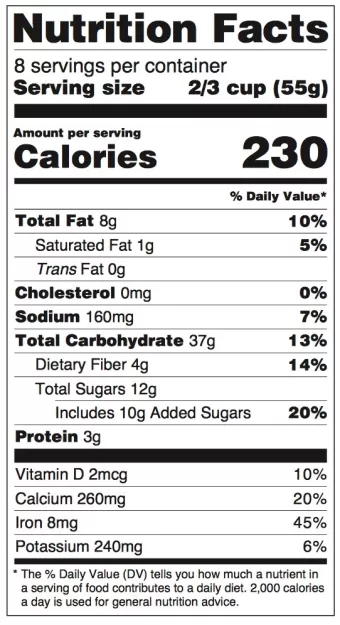Reading the Food Label

By: Amy Tackett, MS, RDN, LD
Reading the nutrition facts on a food label can feel intimidating and overwhelming, especially with the abundance of nutrition information available on the internet. Understanding the key points in what to look for will help you know exactly what you are eating and how to make healthier choices. The front of the package may provide misleading labels, be sure to look at the back of a product for the nutrition facts. These four categories follow the nutrition facts food label from top to bottom for ease of reading.
-
Serving Size
-
Serving sizes are created by the Food and Drug Administration based on how much is typically being eaten in one sitting, NOT based on how much should be eaten in one sitting. Check to see how much a serving size is and how many servings are in the container. Ask yourself how much you plan on eating to determine how many servings will be eaten. For example, the nutrition label below shows a food with a 2/3 cup serving size. If you plan to have 1/3 cup – all nutrition information would be half of what is listed since you would be eating half of the 2/3 cup serving.
-
-
Calories
-
Calories are the measurement of energy in foods. On the nutrition label, calories are shown as how much energy is provided from one serving of this food. Remember that the calories will change if more or less than the one serving is being eaten. The example below shows a product containing 230 calories per 2/3 cup serving.
-
How many calories should you be looking for? Each person requires a different level of energy (calories) each day to maintain a healthy weight. Talk with a qualified health professional to determine how many calories you should take in each day. From there, you can determine if the number of calories in one product is appropriate for your total daily calorie intake. See the continued points for more information in determining if the nutrients it contains fit your goals.
-
-
Nutrients
-
Be sure to get enough fiber, vitamins and minerals including vitamin D, calcium, iron and potassium (shown in the example food label at the bottom).
-
Limit saturated fat, trans fat, cholesterol, sodium and added sugars to reduce the risk of chronic diseases.
-
Choose an appropriate amount of calories, protein, carbohydrate and fat based on your needs.
-
-
% Daily Value
-
The % daily value shows how much one serving contributes to the total recommended amount of that nutrient for a day based on a 2000 calorie a day diet. Remember that your recommended number of calories and nutrients may vary. Use the % daily value as a guideline in understanding how much of the key vitamins and minerals products have.
-
Use these 4 key components of the nutrition facts label to compare products and better understand the foods you eat.
Contact our registered dietitian nutritionist for a consultation to talk through your health-related questions and your personalized nutrition advice.
Be sure to check back for expanded blogs on
reading the nutrition facts food labels.
References
Changes to the Nutrition Facts Label. (n.d.). Food and Drug Administration. Retrieved from https://www.fda.gov/food/food-labeling-nutrition/changes-nutrition-facts-label
How to Understand and Use the Nutrition Facts Label. (n.d.). Food and Drug Administration. Retrieved from https://www.fda.gov/food/nutrition-education-resources-materials/how-understand-and-use-nutrition-facts-label
Tips for Using the Food Label. (n.d.). Office of Disease Prevention and Health Promotion.
Amy Tackett is the Registered Dietitian Nutritionist for the YMCA of Greater Dayton. Interested in learning more? See our Nutrition page.

